It looks like you're using an Ad Blocker.
Please white-list or disable AboveTopSecret.com in your ad-blocking tool.
Thank you.
Some features of ATS will be disabled while you continue to use an ad-blocker.
share:
originally posted by: Wolfenz
what gets me is the Complex Work of the Stones in Puma Punku
to me and a few other here on ATS way back when on a few thread s
Look as if the H Blocks were Manufactured in assembly line
were placed in a mold and Poured. all Perfect & Accurate
and Interlocking Pieces
Regarding molding, you can't mold andesite so you're thinking geologists can't identify stone.
Besides that, there are stones at Tiahuanaco and Pumapunku that show different stages of completion on the same stone. You can see one of them (figure 23) in this pdf.
The same paper (by Protzen, the number one expert in the world on ancient South American architecture) mentions evidence of chisels and punches that were used, and the fact that a large number of the stones have scratches and gouges on one side where they were dragged from the quarries.
Harte
You know what they kind of look like to me? The fragments of a kind of sluice system that might be used to separate gold from gravel.
originally posted by: jeep3r
originally posted by: Wolfenz
I still claim that there Once was a One World Civilization
There is many Similarities of the Old Work at the Puma Punku site that Shows in Designs from Ancient Egypt, Ancient Ethiopian and Ancient Sumerian Stone Masonry Work
I think one of the indications for ancient builders having been active across continents long ago are the megalithic polygonal walls with precision fitting that we find in Greece, Italy, Peru and other places across the globe.
Sceptics of this idea believe that the ancients all came up indepedently with this construction style as a logical progression of dry stone walling.
But there are yet other similarities to be found in ancient megalithic masonry, which is why I believe there has been some kind of transcontinental contact between these cultures in the past.
I Agree Adjacent corner Poly stone work mixture of Large to Small Stones fitting like a Puzzle , for the Purpose
of a better stable wall ,
Let alone The Poured Metal Brackets into Large Stone Work
Found in Egypt , Iran Iraq , and Peru
Cambodia Guatamala

Sumerian what The ziggurat should look like
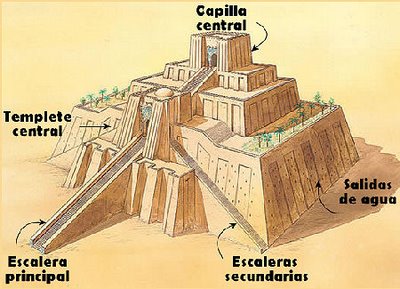
Mayan
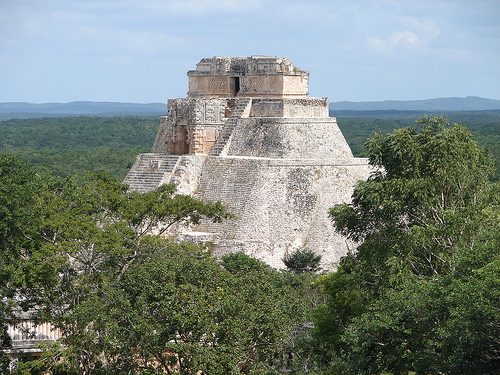
Pyramid of the Sun Mexico
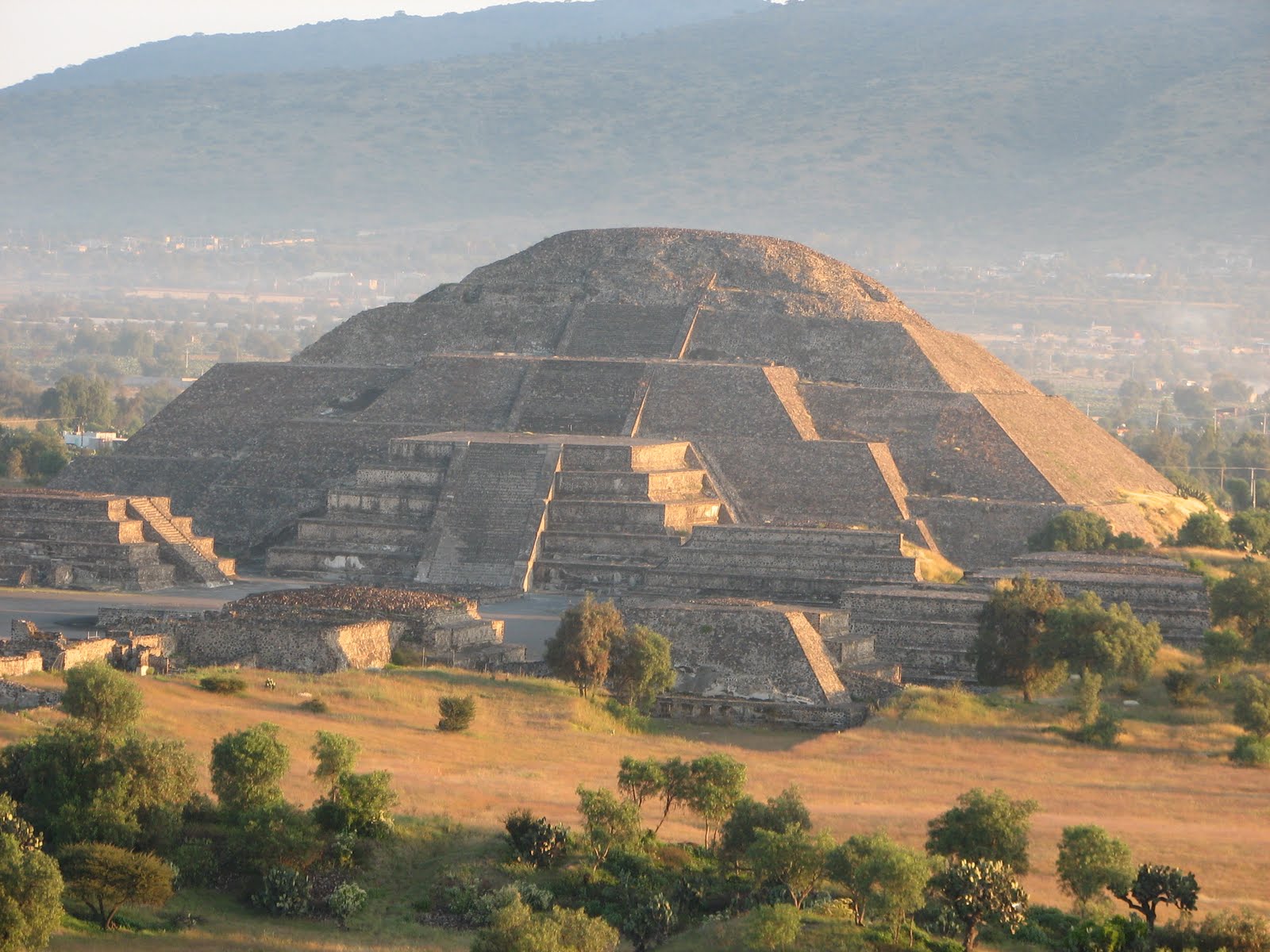
from all this I still say Puma Punku is the Most Complexed of them all!
a Out of Place Ruin for sure , and to me the Most Complex Tech Design
Sketch just as it was seen in the late 1800s
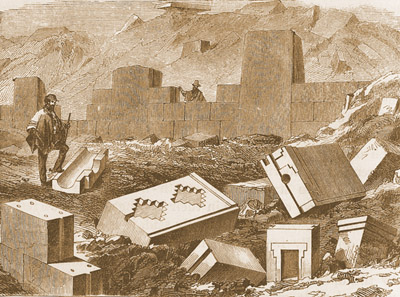
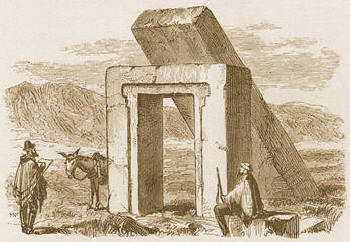
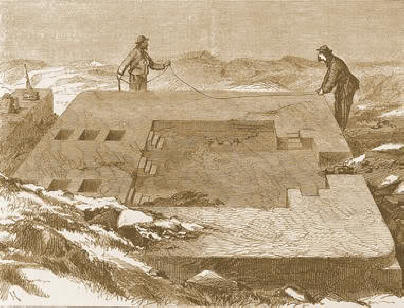
H - Blocks
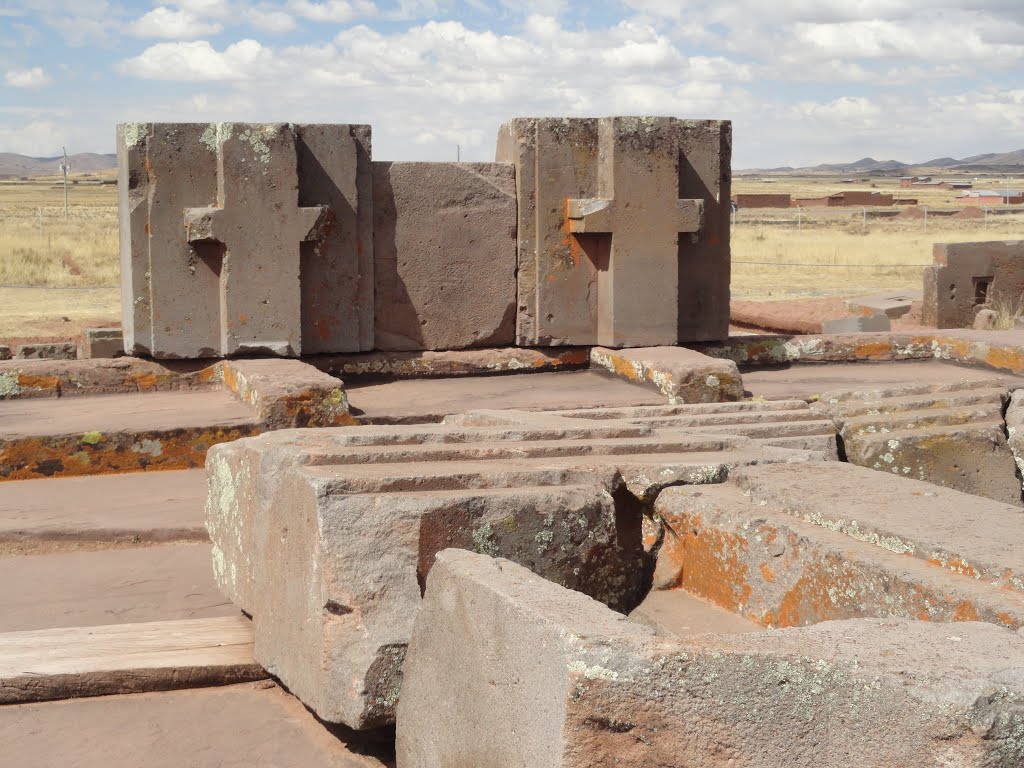
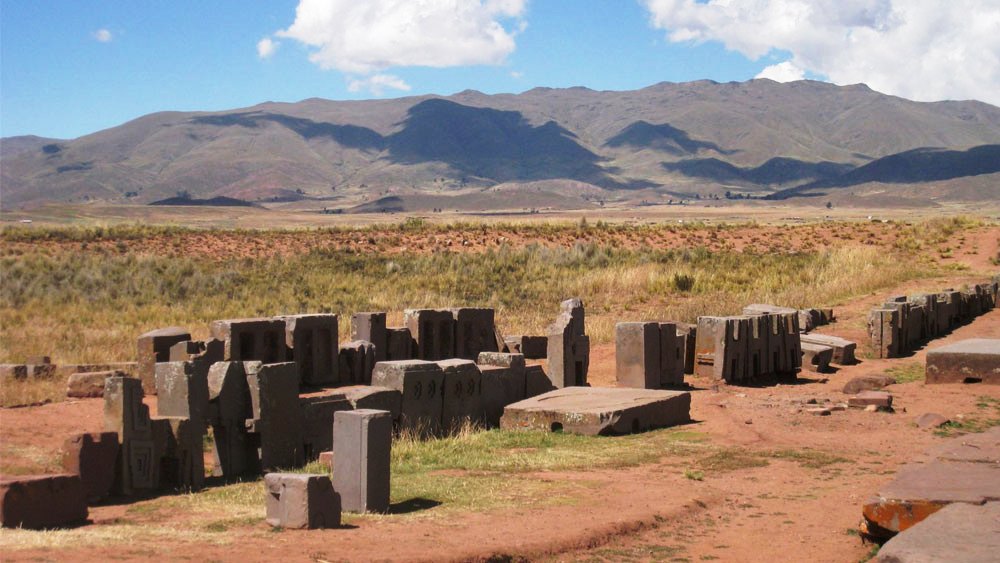
originally posted by: Harte
originally posted by: Wolfenz
what gets me is the Complex Work of the Stones in Puma Punku
to me and a few other here on ATS way back when on a few thread s
Look as if the H Blocks were Manufactured in assembly line
were placed in a mold and Poured. all Perfect & Accurate
and Interlocking Pieces
Regarding molding, you can't mold andesite so you're thinking geologists can't identify stone.
Besides that, there are stones at Tiahuanaco and Pumapunku that show different stages of completion on the same stone. You can see one of them (figure 23) in this pdf.
The same paper (by Protzen, the number one expert in the world on ancient South American architecture) mentions evidence of chisels and punches that were used, and the fact that a large number of the stones have scratches and gouges on one side where they were dragged from the quarries.
Harte
so your going on what we only Discovered in Science and our ( What we Know so Far )
Modern technolagy has Eh ?
Well , there could be a way
you said
Regarding molding, you can't mold andesite so you're thinking geologists can't identify stone.
LOL
Adesite Volcanic Rock well ,
who to say the cant melt it right!
Seeing they melt metal and Pour the metal in semi molds to make Brackets, You Know those Brackets to hold Large Stones together Right ? but i doubt you would ever think that Indigenous Natives ( INCAS ) that had no Written language ( except for Knot Roping like a Dam Wampum Belt ) would Carry around a Portable Foundry ,
or a Miniature Smelting Pot ( ON the Construction SITE ) do you ?
Can you really Trust geologist? I would like to go there to see myself and my Own Testing ,
ohh yeah well...
Do–it–yourself lava flows: Science, art and education in the Syracuse University Lava Project
www.earthmagazine.org...
there are stones at Tiahuanaco and Pumapunku that show different stages of completion on the same stone. You can see one of them (figure 23) in
Stop right there .... lets ! Skipp Tiahuanaco ..
Why , it was reassembled by the last century
just about the whole site!! late 19th century up to the 1920s
I consider Tiahunaco was built in a different time frame more primitive the Puma Punku
not saying Older , just the lack of technology of Building
anyhow
Please explain to me how the Incas cut the stone like this ???
a Civilization with just knot roping for a written language
and a Civilization in the Early Bronze Age stage ..
Ollantaytambo Quarry

Ollantaytambo - Puma Punku Design
www.youtube.com...
Ollantaytambo – Say that three times fast
bellaremyphotography.com...
Speaking of Andesite .... Harte
Puma Punku: Ancient Alien Technology From 12,000 Years Ago?
www.youtube.com...
Well OP here ya Go : closer look on the H blocks with Brian Forester
which I happen Message on Occasion. A guy That is Been there :
Even tho He is Convinced that at the Puma Punk Site High Technology
from a Higher Advanced Civilization then the INCAS that constructed the site
Puma Punku In Bolivia: High Tech Megalithic Site Destroyed 12,000 Years Ago
www.youtube.com...
which I happen Message on Occasion. A guy That is Been there :
Even tho He is Convinced that at the Puma Punk Site High Technology
from a Higher Advanced Civilization then the INCAS that constructed the site
Puma Punku In Bolivia: High Tech Megalithic Site Destroyed 12,000 Years Ago
www.youtube.com...
edit on 12017MondayfAmerica/Chicago6162 by Wolfenz because: (no reason given)
originally posted by: VVV88
a reply to: micpsi
Looks like they were made from poured cement out of wooden forms, not chisled.
what I think is They could of been Poured then chiseled for
finishing touches to the Stones
as Brian Forester Pointed out ,
there is One out of the 9 H Blocks he showed in his Youtube video
that was unfinished or perhaps the process was too be re melted the Area & place a casting /mold
onto it places in india has similar idea ,
I absolutely love the puma Punku site. As well as the other megalithic sites of Peru/Bolivia, and Central America, and Egypt and the Middle East. I
enjoy Brien Foerster's videos and his theory (maybe it's not his theory but I first heard it through him, I haven't read his books yet) about how in
the past there was some kind of high technology or something we can't duplicate/replicate. And how there was a cataclysm or a kind of apocalypse about
12,000 years ago. Everything was buried in mud and sand. Some of the stones in his videos show scorch marks and evidence of melting and
vitrification.
Also I'm not a religious person but the story of the Tower of Babel has a line about how "they rebuilt with brick, not stone". Indicating that they'd lost the ability to work stone the same way. Not sure if that ties in or what but I like to imagine it does.
Has anyone heard about the towers of sillustani? The pre-inca ones get wider and wider every millimeter up but are still made with no mortar. They were all destroyed (12,000 years ago as well?) and I believe they all kinda exploded in one direction, leaving a cross section of themselves standing. I find them to be quiet strange. What purpose could they possibly have served?
Am I the only one who feels like...to heck with preserving things? Let's dig them up. Dig everywhere. Just document everything and keep it all legit and transparent. Dig up the pyramids. Dig up puma Punku. Dig up the other megalithic sites. Just try not to destroy them I guess? Hehe okay maybe not the best idea..
Also I'm not a religious person but the story of the Tower of Babel has a line about how "they rebuilt with brick, not stone". Indicating that they'd lost the ability to work stone the same way. Not sure if that ties in or what but I like to imagine it does.
Has anyone heard about the towers of sillustani? The pre-inca ones get wider and wider every millimeter up but are still made with no mortar. They were all destroyed (12,000 years ago as well?) and I believe they all kinda exploded in one direction, leaving a cross section of themselves standing. I find them to be quiet strange. What purpose could they possibly have served?
Am I the only one who feels like...to heck with preserving things? Let's dig them up. Dig everywhere. Just document everything and keep it all legit and transparent. Dig up the pyramids. Dig up puma Punku. Dig up the other megalithic sites. Just try not to destroy them I guess? Hehe okay maybe not the best idea..
a reply to: jeep3r
It seems many seem to look past the very simple fact that like these and many older sites, those stone cuts are very fine and strait. That would today be completed with industry saws, yet they did not have such tools. To create these shapes seriously do not match up with the time period. It seriously points to something not quite right about our history.
Rather we have achieved industry before and was wiped out or some intervention occurred in our past.
It seems many seem to look past the very simple fact that like these and many older sites, those stone cuts are very fine and strait. That would today be completed with industry saws, yet they did not have such tools. To create these shapes seriously do not match up with the time period. It seriously points to something not quite right about our history.
Rather we have achieved industry before and was wiped out or some intervention occurred in our past.
a reply to: jeep3r
the thing that always really screamed at me is there arent any other buildings like this in the region or anywhere else on earth , with such modular ideas , the way they are cut etc
there is more than meets the eye for sure
great thread and will continue to read up on it again in case I have missed something
the thing that always really screamed at me is there arent any other buildings like this in the region or anywhere else on earth , with such modular ideas , the way they are cut etc
there is more than meets the eye for sure
great thread and will continue to read up on it again in case I have missed something
originally posted by: Wolfenz
originally posted by: Harte
originally posted by: Wolfenz
what gets me is the Complex Work of the Stones in Puma Punku
to me and a few other here on ATS way back when on a few thread s
Look as if the H Blocks were Manufactured in assembly line
were placed in a mold and Poured. all Perfect & Accurate
and Interlocking Pieces
Regarding molding, you can't mold andesite so you're thinking geologists can't identify stone.
Besides that, there are stones at Tiahuanaco and Pumapunku that show different stages of completion on the same stone. You can see one of them (figure 23) in this pdf.
The same paper (by Protzen, the number one expert in the world on ancient South American architecture) mentions evidence of chisels and punches that were used, and the fact that a large number of the stones have scratches and gouges on one side where they were dragged from the quarries.
Harte
so your going on what we only Discovered in Science and our ( What we Know so Far )
Modern technolagy has Eh ?
Well , there could be a way
Yes, I go on what is KNOWN, not what people fantasize about, when I attempt to understand a thing.
originally posted by: Wolfenzyou said
Regarding molding, you can't mold andesite so you're thinking geologists can't identify stone.
LOL
Adesite Volcanic Rock well ,
who to say the cant melt it right!
Consistent application of enough heat to bring the stone to over 1200 deg,. F. Over and over and over, given the number of blocks. Please provide your evidence of any such operation in ancient Bolivia.
originally posted by: WolfenzSeeing they melt metal and Pour the metal in semi molds to make Brackets, You Know those Brackets to hold Large Stones together Right ? but i doubt you would ever think that Indigenous Natives ( INCAS ) that had no Written language ( except for Knot Roping like a Dam Wampum Belt ) would Carry around a Portable Foundry ,
or a Miniature Smelting Pot ( ON the Construction SITE ) do you ?
The history of metallurgy in the region is fairly well known. Yes, what you refer to here as "foundries" have been found, mostly associated with the Wari, if you know who they are.
originally posted by: WolfenzCan you really Trust geologist? I would like to go there to see myself and my Own Testing ,
ohh yeah well...
You can't tell andesite from granite, but you feel more qualified than a professional geologist.
Forgive me if I doubt that very much.
originally posted by: Wolfenz
there are stones at Tiahuanaco and Pumapunku that show different stages of completion on the same stone. You can see one of them (figure 23) in
Stop right there .... lets ! Skipp Tiahuanaco ..
Why , it was reassembled by the last century
just about the whole site!! late 19th century up to the 1920s
I consider Tiahunaco was built in a different time frame more primitive the Puma Punku
not saying Older , just the lack of technology of Building
Here's an example of how little you know. Pumapunku is a part of the Tiahuanaco site and the construction at Pumapunku post dates much of the rest of the construction on the site.
originally posted by: WolfenzPlease explain to me how the Incas cut the stone like this ???
a Civilization with just knot roping for a written language
and a Civilization in the Early Bronze Age stage ..
Ollantaytambo Quarry
Ollantaytambo - Puma Punku Design
www.youtube.com...
You dreamed up this "early Bronze Age" crap. The Inca were VERY accomplished metallurgists and had some of the best bronze ever found in all of South America.
They were certainly excellent stonemasons as well, but Ollantaytambo's large megaliths are limestone, which splits fairly easily along practically perpendicular planes.
originally posted by: WolfenzOllantaytambo – Say that three times fast
bellaremyphotography.com...
Speaking of Andesite .... Harte
Puma Punku: Ancient Alien Technology From 12,000 Years Ago?
www.youtube.com...
I don't watch videos as evidence - only for entertainment and never on my computer, due to certain duties I have here at home (my son is autistic.) Can you not speak for yourself?
Harte
edit on 6/13/2017 by Harte because: of the wonderful things he does!
originally posted by: Wolfenz
what I think is They could of been Poured then chiseled for finishing touches to the Stones
The currently accepted theory for stoneworking techniques at Tihuanaco and Puma Punku is only that: a "theory". J.P. Protzen and S. Nair indicate in their paper that "unknowns" are involved in the process:
Who Taught the Inca Stonemasons Their Skills? (p. 156)
[...] But to obtain the smooth finishes, the perfectly planar faces, and exact right interior and exterior angles on the finely dressed stones, they resorted to techniques unknown to the Incas and to us at this time.
Figure 23 in the PDF linked above is also interesting since it displays a block with both a fine finish and a roughly worked part.
On the other hand, I think that Ewald Schuster actually makes quite a good case for the molding theory. Especially his assessment of a "flawed" corner (see here) in a block with otherwise perfect geometry lends some credence to his approach. I read his entire website yesterday and found it to be quite inspiring.
edit on 13-6-2017 by jeep3r
because: text
Yes, of course thats right, ou can't mold andesite .
My point in the two links I posted was NOT to claim that these huge blocks were molded.
I find it nevertheless very interesting that a professional molder/ caster is experiencing.
My point in the two links I posted was NOT to claim that these huge blocks were molded.
I find it nevertheless very interesting that a professional molder/ caster is experiencing.
When the con lands in a crete' you know why there is a term called the slur of "Cretan" when they mixed up the creation stories and tried to rule them
all in a perpetual war. That is still on going by the way... like duh right?
Well, we all used to share trade and meet on peacful terms... then they did that high lander business which meant the flood, well the flood of what germs and bacteria that other cultures were not used too, so the "race mixing" got the finger poined at it and the racism really began.
Heads up because if we were a different species or were not meant to mix and flourish all over the earth the sperm and egg would not work together.
Out of the womb that seems to be the case... you can't make a "cat/dog" without fiction or a genetically modified organism if we look to the past of the Anunnaki it is a been there done that situation.
Headed there again? Well, we didn't cross that hurdle the last time when the earth split after the asteroid become a metorite this Neptuniain plant gained a big puddle of mud the continents split from pangea and life that developed got separated.
Saturn is a moon builder, Uranus is a moon builder(no joke intended) and when the earth got smacked the dust hit the inner/outer space and seeded the planet with the simple sugars and building blocks for it to churn as those rings settled the meteor chunks formed a moon over a vast amount of time ebbing and flowing tides and there is a chunk still out there in perpetual orbit in recent sky scope developments.(if that is from the origional impact or left over from when the dinos bit the bullet I cannot say but that was what lead to the first ice age that we are still crawling out of.
But concrete; all that is is a process called quick lime... acid from citric fruits not only cure scurvy(which was very benifical and prized by sailors) but all when mixed with rock could be poured into forms.
Mills could not only grind meals but rock... stone ground works more than one way, due to the MOHLs scale of hardness or density.
So no biggie. But yes biggie as in the megolitic structures. How is this possible and why was it lost? Well the entire earth was temperate until that asteriod becoming a meteorite and left things "frozen" those ;and locked and with time on their hands pulled resources and knew of the others.
Believing in old myth and legend they thought a "god" did it so they in hive minds from those beliefs out of animism rolled around and then started invasions for those resources in a invasion like fashion.
We are still working back towards unity of the world but those old greeds, hates, out of that ignorance still exist so of course the world government has to shift sands and funnel around to try and equalize or pull things back into balance for "spaceship earth".
Well, we all used to share trade and meet on peacful terms... then they did that high lander business which meant the flood, well the flood of what germs and bacteria that other cultures were not used too, so the "race mixing" got the finger poined at it and the racism really began.
Heads up because if we were a different species or were not meant to mix and flourish all over the earth the sperm and egg would not work together.
Out of the womb that seems to be the case... you can't make a "cat/dog" without fiction or a genetically modified organism if we look to the past of the Anunnaki it is a been there done that situation.
Headed there again? Well, we didn't cross that hurdle the last time when the earth split after the asteroid become a metorite this Neptuniain plant gained a big puddle of mud the continents split from pangea and life that developed got separated.
Saturn is a moon builder, Uranus is a moon builder(no joke intended) and when the earth got smacked the dust hit the inner/outer space and seeded the planet with the simple sugars and building blocks for it to churn as those rings settled the meteor chunks formed a moon over a vast amount of time ebbing and flowing tides and there is a chunk still out there in perpetual orbit in recent sky scope developments.(if that is from the origional impact or left over from when the dinos bit the bullet I cannot say but that was what lead to the first ice age that we are still crawling out of.
But concrete; all that is is a process called quick lime... acid from citric fruits not only cure scurvy(which was very benifical and prized by sailors) but all when mixed with rock could be poured into forms.
Mills could not only grind meals but rock... stone ground works more than one way, due to the MOHLs scale of hardness or density.
So no biggie. But yes biggie as in the megolitic structures. How is this possible and why was it lost? Well the entire earth was temperate until that asteriod becoming a meteorite and left things "frozen" those ;and locked and with time on their hands pulled resources and knew of the others.
Believing in old myth and legend they thought a "god" did it so they in hive minds from those beliefs out of animism rolled around and then started invasions for those resources in a invasion like fashion.
We are still working back towards unity of the world but those old greeds, hates, out of that ignorance still exist so of course the world government has to shift sands and funnel around to try and equalize or pull things back into balance for "spaceship earth".
a reply to: Harte
so your going on what we only Discovered in Science and our ( What we Know so Far )
Modern technolagy has Eh ?
Well , there could be a way
Fantasize! ? LOL well some just call it Theory and Science Loves theory's
and some theory's become fact when Science/Tech catches up.
Sorry I Go Beyond that , When I see Complex Designs in Structures that they ( The Incas ) Supposedly Built ,
yeah sure they may of Helped in the Process
but they are not the architects nor the Designers that created the High Technology
well.. didtn you say the Incas had Smelting foundries all over the Area ?
The Melted Vitrified rock is all over Peru Michu Pichu , Sacsayhuaman and Ollantaytambo
Google : Incan Vitrified Rock or Bolivia vitrified rock
LOL. Well at least I can see for my self, the evidence of what the stone are made of right ?
Im a Professional Welder, that had classes in metallurgy , depends on what , professional geologist
your talking about , I think you mean Mineralogist
Here's an example of how little you know. Pumapunku is a part of the Tiahuanaco site and the construction at Pumapunku post dates much of the rest of the construction on the site.
OMG!! I think you need to Creep on into my Post! on debates about Puma Punku
of what i had discussed long ago !
well No crap Harte! LOL of Course its a Part of Tiwananco
ok we have a lesser crude LOW Tech technology of Construction ! that would be Tiwanaco
and we have a Very HIGH Tech at the Puma Punku Site ! yet supposedly the same time frame
give or take a century my belief and The Incas built the man Part Tiwanaco, with Help
but the Ruins of Puma Punku , isn't Designed from The INCAS alone.. a Traveler from the other side of the world just may of had a Hand in it , as I said before the Tiwananco site was reconstructed by the Modern locals and The Archaeologist that visited there.. there documents of that , even Photos
it is Bronze Age , so you going to tell me The INCAS Advance to the iron Age any evidecne on that ? any Iron that had been fouind amazing feat , with out some kind of Hand Written Lanquage , well at least the Mayans has some hrogyphs .
well you should , and you can make the judgement call, never on your computer?
yet here you are reading and typing away ?? and you cant watch a 8 minute video ?
hey I know about being autisitc , form the Mild and the Severe! the the dealings along with it
it not what people think , they have a normal intelect mind trapped in a body that doesnt want to funtion nor communicate , its Like Sleep paralisas when your are alert and awake ,
so your going on what we only Discovered in Science and our ( What we Know so Far )
Modern technolagy has Eh ?
Well , there could be a way
Yes, I go on what is KNOWN, not what people fantasize about, when I attempt to understand a thing.
Fantasize! ? LOL well some just call it Theory and Science Loves theory's
and some theory's become fact when Science/Tech catches up.
Sorry I Go Beyond that , When I see Complex Designs in Structures that they ( The Incas ) Supposedly Built ,
yeah sure they may of Helped in the Process
but they are not the architects nor the Designers that created the High Technology
Consistent application of enough heat to bring the stone to over 1200 deg,. F. Over and over and over, given the number of blocks. Please provide your evidence of any such operation in ancient Bolivia.
well.. didtn you say the Incas had Smelting foundries all over the Area ?
The Melted Vitrified rock is all over Peru Michu Pichu , Sacsayhuaman and Ollantaytambo
Google : Incan Vitrified Rock or Bolivia vitrified rock
You can't tell andesite from granite, but you feel more qualified than a professional geologist. Forgive me if I doubt that very much.
LOL. Well at least I can see for my self, the evidence of what the stone are made of right ?
Im a Professional Welder, that had classes in metallurgy , depends on what , professional geologist
your talking about , I think you mean Mineralogist
Here's an example of how little you know. Pumapunku is a part of the Tiahuanaco site and the construction at Pumapunku post dates much of the rest of the construction on the site.
OMG!! I think you need to Creep on into my Post! on debates about Puma Punku
of what i had discussed long ago !
well No crap Harte! LOL of Course its a Part of Tiwananco
ok we have a lesser crude LOW Tech technology of Construction ! that would be Tiwanaco
and we have a Very HIGH Tech at the Puma Punku Site ! yet supposedly the same time frame
give or take a century my belief and The Incas built the man Part Tiwanaco, with Help
but the Ruins of Puma Punku , isn't Designed from The INCAS alone.. a Traveler from the other side of the world just may of had a Hand in it , as I said before the Tiwananco site was reconstructed by the Modern locals and The Archaeologist that visited there.. there documents of that , even Photos
You dreamed up this "early Bronze Age" crap. The Inca were VERY accomplished metallurgists and had some of the best bronze ever found in all of South America. They were certainly excellent stonemasons as well, but Ollantaytambo's large megaliths are limestone, which splits fairly easily along practically perpendicular planes.
it is Bronze Age , so you going to tell me The INCAS Advance to the iron Age any evidecne on that ? any Iron that had been fouind amazing feat , with out some kind of Hand Written Lanquage , well at least the Mayans has some hrogyphs .
I don't watch videos as evidence - only for entertainment and never on my computer, due to certain duties I have here at home (my son is autistic.) Can you not speak for yourself? Harte
well you should , and you can make the judgement call, never on your computer?
yet here you are reading and typing away ?? and you cant watch a 8 minute video ?
hey I know about being autisitc , form the Mild and the Severe! the the dealings along with it
it not what people think , they have a normal intelect mind trapped in a body that doesnt want to funtion nor communicate , its Like Sleep paralisas when your are alert and awake ,
originally posted by: jeep3r
originally posted by: Wolfenz
what I think is They could of been Poured then chiseled for finishing touches to the Stones
The currently accepted theory for stoneworking techniques at Tihuanaco and Puma Punku is only that: a "theory". J.P. Protzen and S. Nair indicate in their paper that "unknowns" are involved in the process:
Who Taught the Inca Stonemasons Their Skills? (p. 156)
[...] But to obtain the smooth finishes, the perfectly planar faces, and exact right interior and exterior angles on the finely dressed stones, they resorted to techniques unknown to the Incas and to us at this time.
Figure 23 in the PDF linked above is also interesting since it displays a block with both a fine finish and a roughly worked part.
On the other hand, I think that Ewald Schuster actually makes quite a good case for the molding theory. Especially his assessment of a "flawed" corner (see here) in a block with otherwise perfect geometry lends some credence to his approach. I read his entire website yesterday and found it to be quite inspiring.
Thanks for Posting got the Pdf , going to read it soon ,
Figure 23 in the PDF linked above is also interesting since it displays a block with both a fine finish and a roughly worked part
just as Brien Forester had mention in the Video ive recently posted on this Thread
On the mold theory. What did they make the mold out of? I mean they had to get the crisp cuts on the inside of the mold. Would something amazing have
to be made either as a positive or a negative buck to create the mold? In my experience you need a master before any molding process can
begin.
edit on 16-6-2017 by Darkstar12 because: (no reason given)
a reply to: Darkstar12
The master is in the aether. Even the little ones who leap forth have forgotten the origins of this site.
The master is in the aether. Even the little ones who leap forth have forgotten the origins of this site.
originally posted by: Darkstar12
On the mold theory. What did they make the mold out of? I mean they had to get the crisp cuts on the inside of the mold. Would something amazing have to be made either as a positive or a negative buck to create the mold? In my experience you need a master before any molding process can begin.
When using cement, wood would be a suitable material for making molds, at least according to this site.
But, as Schuster writes:
Kantatallita: Puma Punku Theories
The question is did they know how to make a stone like slurry that has fooled us to this day that these are real rocks?
Based on samples brought back by Uhle and Stübel from their 1890s field trip, it seems that most of the grey-colored blocks we're talking about here are made of volcanic andesite.
Back then, they asked Dr. W. Bergt, assistant at the Mineralogical Museum in Dresden, to analyze the Puma Punku stone material. According to Bergt, these consist of:
1. Tridymite-Biotite-Pyroxene Andesite (Gate of Ak-kapana)
2. Olivine-Pyroxene Andesite (block on p. 38, figure 26)
3. Amphibole Andesite
4. Quartz-Amphibole Andesite
5. Pyroxene Andesite
6. Biotite-Pyroxene-Amphibole Andesite
7. Propylitic-Quartz-Biotite-Amphibole Andesite (= Dacite)
And quite a few artifacts are of course also made of locally available red sandstone. So if we continue speculating about the mold theory, it would be interesting to know if there are more recent analyses available that take into account the progress made in materials sciences and mineralogy since then.
edit on 16-6-2017 by jeep3r because: text
originally posted by: Darkstar12
On the mold theory. What did they make the mold out of? I mean they had to get the crisp cuts on the inside of the mold. Would something amazing have to be made either as a positive or a negative buck to create the mold? In my experience you need a master before any molding process can begin.
well not necessarily crisp cuts from the mold , but the finishing touches ( the next Step in the Process ) after the blocks been Made from the mold , Right a master ..
this is how I look it ,
when a Modern Construction Company makes a ( Masonry ) Building
with their High tech Tools in or from a different Country
they Usually don't leave Machinery behind
nor their Tools Behind ,
So where is the Time frame Progress of Improvements
over the years Decades too Centuries in Bolivia Puma Punku ?
I don't see that in Peru Bolivia , Nor in Mexico or In between.
That why their may have been, a Foreigner Traveler from the Old World that Helped
Built it.
new topics
-
Intro once again
Introductions: 24 minutes ago -
University student disciplined after saying veganism is wrong and gender fluidity is stupid
Education and Media: 1 hours ago -
Geddy Lee in Conversation with Alex Lifeson - My Effin’ Life
People: 2 hours ago -
God lived as a Devil Dog.
Short Stories: 2 hours ago -
Police clash with St George’s Day protesters at central London rally
Social Issues and Civil Unrest: 4 hours ago -
TLDR post about ATS and why I love it and hope we all stay together somewhere
General Chit Chat: 5 hours ago -
Hate makes for strange bedfellows
US Political Madness: 7 hours ago -
Who guards the guards
US Political Madness: 10 hours ago -
Has Tesla manipulated data logs to cover up auto pilot crash?
Automotive Discussion: 11 hours ago
top topics
-
Hate makes for strange bedfellows
US Political Madness: 7 hours ago, 15 flags -
Who guards the guards
US Political Madness: 10 hours ago, 13 flags -
whistleblower Captain Bill Uhouse on the Kingman UFO recovery
Aliens and UFOs: 16 hours ago, 11 flags -
Police clash with St George’s Day protesters at central London rally
Social Issues and Civil Unrest: 4 hours ago, 8 flags -
TLDR post about ATS and why I love it and hope we all stay together somewhere
General Chit Chat: 5 hours ago, 5 flags -
University student disciplined after saying veganism is wrong and gender fluidity is stupid
Education and Media: 1 hours ago, 4 flags -
Has Tesla manipulated data logs to cover up auto pilot crash?
Automotive Discussion: 11 hours ago, 2 flags -
God lived as a Devil Dog.
Short Stories: 2 hours ago, 2 flags -
Geddy Lee in Conversation with Alex Lifeson - My Effin’ Life
People: 2 hours ago, 2 flags -
Intro once again
Introductions: 24 minutes ago, 1 flags
active topics
-
University student disciplined after saying veganism is wrong and gender fluidity is stupid
Education and Media • 8 • : matafuchs -
Terrifying Encounters With The Black Eyed Kids
Paranormal Studies • 60 • : FlyersFan -
My wife just had a very powerful prophetic dream - massive war in Israel...
The Gray Area • 13 • : BukkaWukka -
Mandela Effect - It Happened to Me!
The Gray Area • 114 • : ArMaP -
Silent Moments --In Memory of Beloved Member TDDA
Short Stories • 69 • : Naftalin -
Hate makes for strange bedfellows
US Political Madness • 32 • : theatreboy -
Police clash with St George’s Day protesters at central London rally
Social Issues and Civil Unrest • 36 • : FlyersFan -
"We're All Hamas" Heard at Columbia University Protests
Social Issues and Civil Unrest • 249 • : marg6043 -
Europe declares war on Russia?
World War Three • 66 • : Consvoli -
Candidate TRUMP Now Has Crazy Judge JUAN MERCHAN After Him - The Stormy Daniels Hush-Money Case.
Political Conspiracies • 732 • : matafuchs
